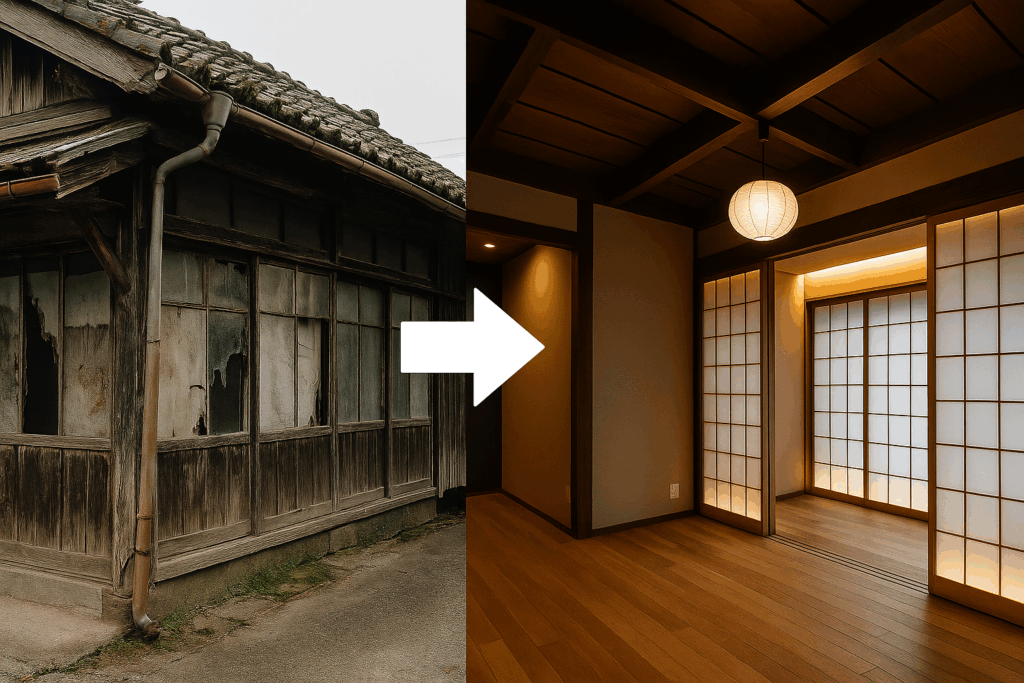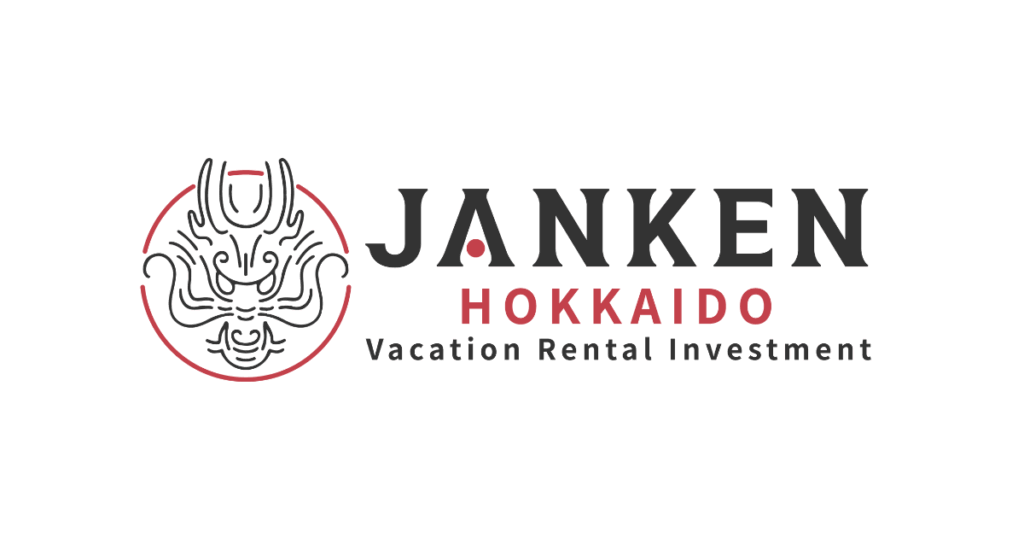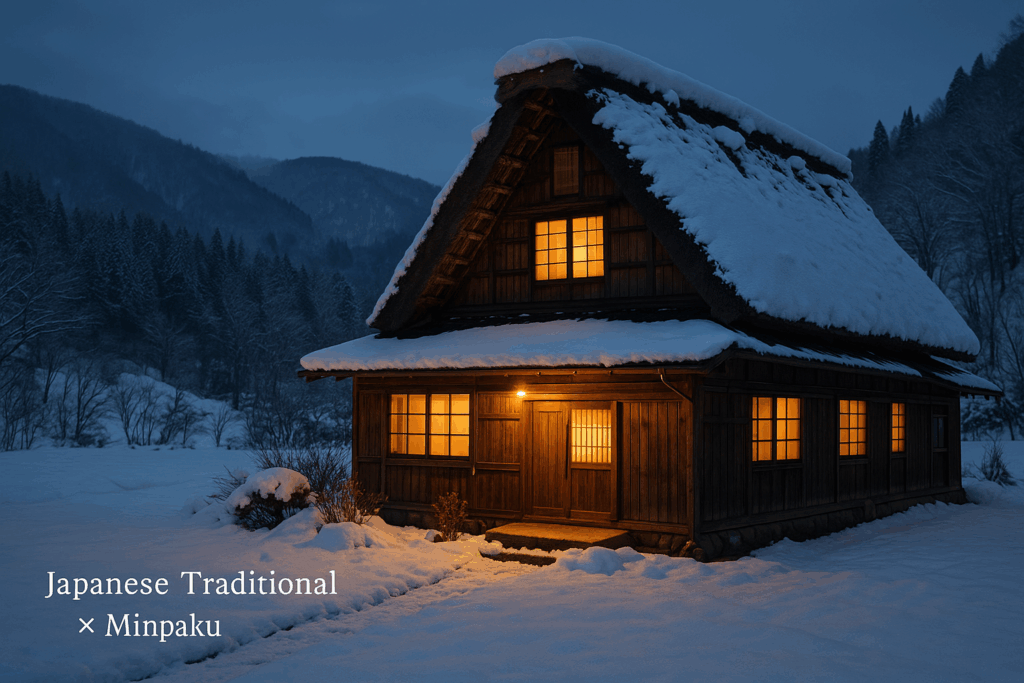The Benefits of Kominka Vacation Rentals in Hokkaido | Renovation and Business Success Strategies
2025.05.19

Hokkaido is home to breathtaking natural scenery and world-renowned tourist destinations. Areas like Furano, Biei, Niseko, and Kutchan are especially popular among both domestic and international travelers.
In these sought-after regions, traditional Japanese houses—kominka—are gaining attention as unique and culturally rich accommodations through vacation rental (minpaku) conversions.
This article explores the key benefits of operating a kominka vacation rental in Hokkaido, with a focus on renovation strategies that lead to successful business outcomes.
We also highlight the strengths and proven success of JANKEN, a Hokkaido-based firm specializing in kominka restoration and vacation rental operations.
Whether you are planning to start a minpaku business or exploring real estate investment opportunities in Hokkaido, this article will provide essential insights to support your journey.
Contents
- 1 Why Are Kominka Vacation Rentals Gaining Attention in Hokkaido?
- 2 The Benefits and Potential of Renovating Traditional Houses for Vacation Rentals
- 3 Key to Success | Renovating Traditional Houses for Vacation Rental Use
- 3.1 Design | Blending Traditional Japanese Aesthetics with Modern Comfort
- 3.2 Functionality | Ensuring Comfort, Safety, and Efficiency for Guests
- 3.3 Legal Compliance | Renovations with Permits and Licenses in Mind
- 3.4 Estimated Renovation Costs and How to Leverage Subsidies
- 3.5 DIY vs. Professional Renovation: Why Experts Matter
- 4 Why JANKEN Is Your Best Partner for Kominka Vacation Rental Success in Hokkaido
- 5 Conclusion | Optimized Renovation Is the Key to Success in Hokkaido’s Kominka Minpaku Market
Why Are Kominka Vacation Rentals Gaining Attention in Hokkaido?

In recent years, the combination of traditional Japanese houses (kominka) and vacation rentals (minpaku) has gained significant traction in Hokkaido’s real estate and regional revitalization sectors.
The region’s booming tourism demand and the resurgence of inbound travel have re-energized the real estate market—especially in prime areas such as Furano, Biei, Niseko, and Kutchan. These destinations are internationally known for their scenic landscapes, distinct seasonal beauty, and cultural richness, making them highly attractive to global travelers.
Among the various lodging options, kominka-style minpaku stands out by offering a unique experience that blends traditional Japanese aesthetics with local hospitality—providing foreign guests with a culturally immersive stay.
At the same time, the use of vacant traditional homes also supports regional development goals. Both national and local governments in Japan are encouraging such initiatives through subsidies, tax incentives, and regulatory support.
With inbound travel rapidly recovering and domestic migration to Hokkaido gaining momentum, the potential of kominka-based vacation rentals is drawing increasing attention from investors and entrepreneurs alike.
In this section, we will explore the market potential and strategic advantages of launching a minpaku business using traditional houses in Hokkaido.
The Benefits and Potential of Renovating Traditional Houses for Vacation Rentals
Turning a traditional Japanese house (kominka) into a vacation rental is an increasingly attractive business model that combines cultural uniqueness with profitability.
Compared to new developments or conventional hotels, the purchase price and renovation cost of kominka properties are often lower, while their integration with local tourism assets enables premium pricing and stronger returns on investment.
In addition, a well-renovated kominka can be positioned as a high-value asset, making it not only a source of income but also a long-term real estate investment.
The architectural charm and historical atmosphere of kominka are especially appealing to foreign travelers and city dwellers looking for peaceful escapes. These properties offer an experience that goes beyond accommodation—one of immersion in tradition and connection with the local lifestyle.
In this section, we explore the major benefits of investing in and renovating kominka properties for vacation rental use in Hokkaido—from financial returns to branding value.
Benefit 1 | High Profitability Compared to Traditional Rentals
One of the biggest advantages of converting a traditional house into a vacation rental is its strong earning potential. In many cases, minpaku operations generate up to twice the income of standard long-term leases.
In areas like Niseko and Kutchan, where global tourism demand is high, kominka properties can command premium nightly rates due to their unique appeal and cultural value.
Likewise, Furano and Biei are increasingly recognized as high-potential destinations, especially during lavender season and ski season, making them excellent locations for vacation rental investment.
Thanks to platforms like Airbnb, property owners can attract international travelers and monetize idle properties as income-generating assets.
Benefit 2 | Unique Identity and Branding Power of Kominka
The architectural features of a kominka—such as exposed wooden beams, earthen floors, and traditional joinery—offer a deeply immersive experience that modern hotels cannot replicate.
For overseas guests, staying in a kominka represents a true cultural journey, combining aesthetics, storytelling, and tradition.
In the age of social media, these visually distinctive interiors naturally encourage guests to share their experiences, enhancing brand exposure and organic marketing.
This “authentic Japan” appeal helps your property stand out from the competition and commands higher guest satisfaction and pricing power.
Benefit 3 | Strong Appeal to Inbound Travelers Visiting Hokkaido
Hokkaido is one of Japan’s most attractive regions for inbound tourism, drawing millions of visitors each year for its nature, seasons, and outdoor activities.
Destinations such as Furano, Niseko, and Biei are globally recognized, often featured in travel media and influencers’ content.
By operating a traditional house as a vacation rental in such areas, hosts can tap into the growing demand for authentic, local, and experience-rich stays.
Well-designed interiors and Japanese-style amenities create “Instagrammable” moments that travelers love to share—further boosting visibility and bookings.
The Pros and Cons of Investing in Vacation Rentals
How to Start a Vacation Rental Business Using Vacant Properties
Key to Success | Renovating Traditional Houses for Vacation Rental Use

Renovating a kominka for vacation rental use requires more than interior decoration—it involves strategic planning across three core areas: design, functionality, and regulatory compliance.
Older traditional homes often lack modern amenities such as insulation, earthquake resistance, and updated plumbing or ventilation systems. These deficiencies must be addressed to ensure guest comfort and safety.
Moreover, operating a minpaku business legally requires compliance with Japan’s lodging laws, such as the Hotel Business Act or Private Lodging Business Act, which often necessitate physical modifications to the property.
In this section, we’ll cover essential renovation strategies, including:
- ・How to combine traditional Japanese aesthetics with modern comfort
- ・Upgrades needed for functionality and safety (heating, water, seismic standards)
- ・Legal requirements and how to design renovations around them
- ・Estimated costs and subsidies available
- ・The difference between DIY vs. professional remodeling, and why hiring experts matters
This section provides a blueprint for investors and property owners to plan a successful kominka vacation rental conversion that meets market expectations and regulatory standards.
Design | Blending Traditional Japanese Aesthetics with Modern Comfort
A successful renovation begins with balancing what to preserve and what to modernize. Features like exposed beams, earthen floors (doma), shoji screens, and plaster walls carry the charm and story of the kominka—these should be retained where possible.
At the same time, the layout and furnishings must be optimized for comfort and usability, especially for international travelers.
Using natural local materials, creating a wa-modern atmosphere, and designing for Instagram appeal all contribute to higher guest satisfaction and review scores.
Functionality | Ensuring Comfort, Safety, and Efficiency for Guests
Hokkaido’s cold climate makes thermal insulation and heating essential. Double-pane windows, modern HVAC systems, and anti-freezing plumbing are minimum requirements for winter operation.
Water-related areas such as bathrooms and kitchens should be renovated to meet modern hygiene and convenience standards.
Additionally, layout should support easy cleaning, storage, and operational flow, helping hosts and managers maintain efficiency and quality.
Seismic reinforcement and structural updates are also strongly recommended for safety and compliance.
Legal Compliance | Renovations with Permits and Licenses in Mind
To operate legally, your property must comply with either the Hotel Business Act (ryokan law) or the Private Lodging Business Act (minpaku law).
In designated areas, Special Minpaku Zones may offer relaxed regulations—but still require specific safety upgrades.
Typical requirements include:
- Fire alarms and extinguishers
- Emergency lighting and exit signage
- Clearly marked evacuation routes
Because traditional homes often require substantial modifications to meet these standards, working with experts familiar with local regulations is highly recommended.
Estimated Renovation Costs and How to Leverage Subsidies
Renovating a kominka for vacation rental use typically requires more investment than a standard home makeover. A realistic budget ranges from ¥5 million to ¥15 million (approx. USD 35,000–100,000), depending on size, condition, and scope of work.
However, Japan offers generous government subsidies to encourage the reuse of vacant homes and the growth of inbound tourism.
Examples include:
- ・Business Restructuring Subsidy
- ・Vacant House Revitalization Grant
- ・Inbound Accommodation Improvement Fund
At JANKEN, we support clients with subsidy strategy, document preparation, and coordination with local governments, helping reduce actual out-of-pocket expenses significantly.
In addition to construction costs, be sure to account for:
- ・Design and project management fees
- ・Legal consulting for licensing
- ・Interior furnishing and equipment
A well-structured financial plan allows for sustainable investment and risk control.
DIY vs. Professional Renovation: Why Experts Matter
While some owners consider DIY renovation to reduce initial costs, traditional homes involve structural complexity, safety risks, and strict regulatory requirements.
Professional support ensures:
- Fire safety and legal compliance
- Efficient insulation, plumbing, and heating systems
- Market-aligned design tailored to guest needs
- Faster approval for permits
Ultimately, professional renovations lead to higher guest satisfaction, smoother operations, and the ability to command higher room rates—making the investment worthwhile.
| Aspect | DIY Renovation | Professional Renovation |
|---|---|---|
| Cost | Lower upfront cost | Higher initial cost |
| Quality & Safety | Depends on skill; may vary | Meets construction & fire safety standards |
| Legal Compliance | Difficult to align with licensing requirements | Smooth coordination from application to approval |
| Branding & Appeal | May lack uniqueness | Custom design tailored to target guest segments |
Renovation Case Studies and Layout Ideas for Vacation Rentals in Hokkaido
Why JANKEN Is Your Best Partner for Kominka Vacation Rental Success in Hokkaido

Renovating and operating a traditional house as a vacation rental involves more than just aesthetic design—it requires legal expertise, project management, and deep local knowledge, especially in a region like Hokkaido with unique climate and regulatory factors.
JANKEN is a specialized company based in Hokkaido that provides end-to-end support for kominka revitalization and vacation rental operations. With extensive experience in Furano, Biei, Niseko, and Kutchan, we offer practical and profitable solutions tailored to each location.
Our strength lies in three pillars:
Expert Renovation & Minpaku Business Know-How
With over 500 vacation rental projects managed, JANKEN brings a unique understanding of how to design, renovate, and operate kominka properties for maximum guest satisfaction and profitability.
We also have access to off-market real estate listings and maintain strong local partnerships that help clients discover high-potential properties early.
Our services include:
- ・High-occupancy interior design strategies
- ・Premium finishes that increase nightly rates
- ・Renovation plans aligned with tourism trends and guest expectations
- ・Regulatory compliance and licensing coordination
- ・Fire safety equipment installation and documentation support
True One-Stop System from Acquisition to Operations
JANKEN offers a fully integrated solution, handling everything from:
- ・Property search and purchase support
- ・Renovation design and construction management
- ・Legal and permit applications
- ・Setup of vacation rental operations
- ・Ongoing cleaning, guest communication, and review management
- ・Future resale and exit strategy planning
We work with a reliable network of real estate agents, construction companies, and hospitality operators, so owners don’t need to coordinate with multiple parties.
This streamlined process allows our clients to focus on investment strategy while we handle the day-to-day complexities.
Understanding Regional Characteristics | Tailored Planning for Hokkaido’s Key Areas
JANKEN’s strength lies not only in renovation and operation but also in its deep understanding of Hokkaido’s diverse regional characteristics, enabling the creation of highly optimized minpaku business plans.
Here, we highlight two high-potential areas—Furano/Biei and Niseko/Kutchan—and outline the unique strategies JANKEN applies to maximize returns and guest appeal in each.
Furano & Biei Area
Furano and Biei are renowned for their stunning seasonal landscapes, including lavender fields, rolling hills, and winter snow scenes. These areas attract both domestic and international travelers who seek nature-rich, slow-travel experiences.
Kominka properties in this region are often more affordable, making it easier to start with a lower initial investment. Many owners choose a hybrid model—using the house as a private vacation home, and renting it out when not in use.
JANKEN provides tailored renovation and design solutions that meet guest expectations while also supporting local culture and sustainability, helping owners build long-term value and community trust.
Niseko & Kutchan Area
Niseko and Kutchan are world-famous ski resort destinations, with high demand from Australian, European, and North American travelers throughout the year—not just in winter.
Given the rising land prices, these areas require higher capital investment, but they offer high nightly rates and short ROI periods.
JANKEN specializes in creating guest-focused layouts, cross-cultural design concepts, and experience-driven stays to differentiate kominka properties from larger hotels.
As international investment returns to Hokkaido, these properties also present strong potential for future resale and capital gain as part of an exit strategy.
Conclusion | Optimized Renovation Is the Key to Success in Hokkaido’s Kominka Minpaku Market

Traditional Japanese houses in Hokkaido offer a rare opportunity to create high-value vacation rentals that combine local charm, cultural immersion, and investment potential.
From the scenic beauty of Furano and Biei to the international appeal of Niseko and Kutchan, the region offers diverse locations where kominka minpaku properties can thrive.
However, operating a profitable vacation rental using a traditional home requires more than just buying a property. You need the right renovation strategy, legal compliance, and long-term planning.
That’s where JANKEN comes in. As a one-stop solution provider, we support everything from property selection, renovation design, licensing, and operations, to exit strategy planning.
If you’re considering starting a kominka minpaku business or exploring how to utilize an existing property, JANKEN is your trusted local partner.
We invite you to contact us for a free consultation. Our experienced team will help you build a custom plan for your property that combines tradition, design, and profit.


















